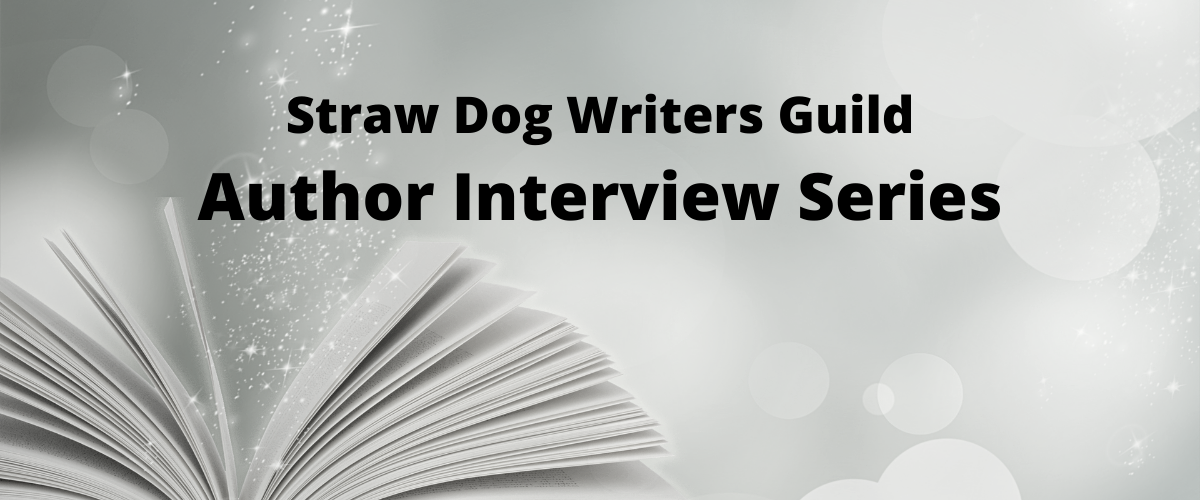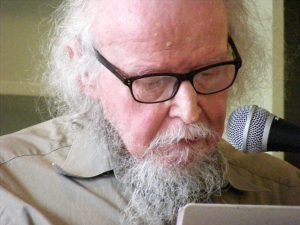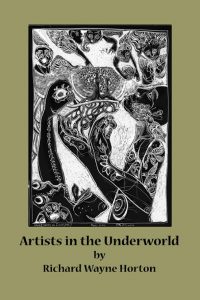Richard Wayne Horton is the author of Sticks and Bones (Meat for Tea Press, 2017), and Artists In The Underworld (Human Error Publishing, 2019). Later this year he will release Ballet for Murderers (Human Error Publishing). Richard writes poetry, flash fiction, and longer fiction, but much of his work is a hybrid of these genres, or might be said to exist outside the definition of any of them. Richard has received two Pushcart nominations and is the 2019-21 Massachusetts Beat Poet Laureate. His work has appeared in Lonesome October, Meat For Tea, Bull & Cross, Literary Heist, The Dead Mule and others. He is a master of the conservation and restoration of books, and has published four technical manuals on the subject, and has written research timelines on the culture of the Left in the 20th century, and on music, art, and literature in Russia from 1730 to 1970.
SDWG: Reading your work is a highly “visual” experience – full of intense images impressions and rich with symbolism. How does your technique as a writer change word into picture in the mind of a reader?
RWH: Thank you for saying my work is a visual experience and is rich, but I do not intend my images to symbolize something. They do call to mind things or experiences charged with meaning for the reader almost in the way that a key unlocks something or an associative word calls forth an emotion or memory. I use simple direct language and a seemingly easy storyline but the choice and arrangement of the images, and the assumptions created by the spoken style, create around the story an unspoken world with its own legacies, rules, and future. I sincerely hope my reader will enjoy my images, but I also hope this reader will consciously or subconsciously experience the tensions at play. I become playful at times with these tensions. You might guess from some of my titles that I enjoy ballet. What I like about it is the kinetic play, the tension and release
SDWG: You’ve spoken of “Literary Cubism.” The term cubism is most often associated with painting. Can you explain how the features of cubism translate to the writing of fiction and poetry?
RWH: My writing is not literary cubist or even modernist in general, though I experimented with modernism when I was younger. My Master’s thesis was about the Chilean poet Vicente Huidobro and his theory of “Creationism,” which he came up with when he came to France in the early years of Modernism when he was in close contact with cubist painters and Franco-Spanish modernist poets. I went ahead and translated one of Huidobro’s chapbooks, Horizon Carre (“square” or “cubed horizon”) and studied his creationist theories. Then while writing my report, I made up my own name for what Huidobro and some other modernist poets were doing: literary cubism. The writer puts phrases on a page, perhaps in a pattern, but by no means randomly. Perhaps the composition speaks to the reader, but not with logic imposed from outside the poem. It could be something like an “eclat,” or a burst of light or gnosis.
In my own work I aim for organic writing that forms itself because of its nature, not from a program, prompt or plot. It may at times read as if it has a plot, because my writing is tight and strongly pointed. I have been inspired or heartened, not influenced, by some of the expressionist writers of the early 20th Century, and by the starkly imagistic writing of romantics such as Georg Buchner.
SDWG: Your interest in Russian art, especially Russian film in the early 20th century, has influenced the form and structure of your work. Can you share a little of this background and connection?
RWH: My work has been described as at times cinematic: bright, spare, and tightly paced, with terse, hard-edged dialogue, as in my story, “Bullets And Horses.” I became interested in Russian music at age 7 because of Tchaikovsky, specifically the tensions he creates, fosters, manages and releases explosively. I became hooked on symphonic and ballet music with a lot of drama, especially Russian romantic music which appropriated village and ethnic dance and story-song rhythms.
I was writing a silly story about a rabbit, a ghost and a mosquito, and the ghost happened to be a Russian composer. I needed background info, so I spent 7 years compiling a Russian music timeline. Turns out you also have to timeline artists, writers, and their European influences, plus political and social trends and the economy. OK, I did that, and was finally able to finish the fuzzy animal story. Done! Lesson learned: unitary vision is not vision. To know yourself you have to leave yourself. Context, sequence and proximity sharpen your (or my) images. Forget cushioning language, psychologising, moralizing, or explaining.
We were chatting about early Russian silent movies. There was a shortage of film in Russia in the early 20s. Russian movie makers couldn’t waste film on a lot of explanatory footage, as D.W. Griffiths was doing in the U.S. Also, many peasants still couldn’t read the captions. Certain producers came up with the idea of letting image sequence tell the story. No words. One image loads the next image. A message or story can reach the peasants without language. Bang! They get it. Subliminal messaging of course can be insidious. But let’s not get into that.
SDWG: Memory also features prominently in your work, but not in a conventional, autobiographical sense. Could you riff a little on how your upbringing in rural Texas, in the middle of the last century, is a wellspring for you, in pieces such as A Long Moment in the South? How do you construct your work so that it operates like actual memory (i.e. outside the bounds of unified linear narrative or chronological order)?
RWH: All of A Long Moment In The South is fiction, and all of it is real. I took a trip to deep memory and found talk, people and places all mixed up with dreams. I had to write them as fiction and make them work as if they were sharply remembered. In a way I was creating real memory. I kept the events clean and the speech authentic. The scenes are practically photographic. That’s the usual tip-off that fiction is occurring. It’s fiction, but it can be every bit as good as memory.
SDWG: On the other hand, Artists in the Underworld, and your new book Ballet for Murderers, operate in a world that is, if not fantasy, at least on the plane of surreal, “magically” real, or as you’ve identified, it hyper-real. In works such as these, where does your content material come from? How do you (forgive the inadequate term) “synthesize” it into the world of the hyper-real?
RWH: The material content of Ballet For Murderers came mostly from how I physically talk about crime, and how my grandma talked about it. My grandma appeared in A Long Moment In The South. She was born in 1904, and picked up her language and attitudes in the 1920s. She had a 20s radio ballad-like way of spinning a tale. She still used some 17th Century country words. I was reading 1660s English street pamphlets when I was pointing and purposing the book. So I slipped in some old language. It sounds fresh and aggressively focussed like 20s radio and 50s noir. Just as the present can replay the past, the past can sound like the present.
SDWG: With these influences and objectives in mind, the conventional elements of plot and resolution become somewhat…inadequate, yes? What opportunities and challenges does this present for you as a writer? How should a reader approach this kind of work differently from those in which the features appear in expected ways?
RWH: Plot and resolution work perfectly for the stories and books many of my friends write. I may someday use them. The work I do now, though it seems at times to be hard-as-nails prose, works like poetry. To enjoy it, take it as it comes, and feel what you feel. If I’ve succeeded, the events and emotions will smack into you. As for my plots, I do try to find an organic story development created by how the story is told and how my characters behave.
SDWG: Earlier we talked about the malleable nature of “logic” in literature. You’ve said that one of the aims of your fiction and poetry (or the combination thereof), is to allow the work to create its own “evolving logic” or “kinetic logic,” in which the order of things evokes an emotional response in the reader, or perhaps a moment of surprise. You’ve called this response a kind of “luminosity.” Can you tell me a little about how this special logic works to elicit this kind of response?
RWH: We were chatting, were we not, about a story logic that is “better” than imported logic. It’s like bones rather than braces. But yes I do like those moments where the reader gets a surprise, or the story pops, with the help of tension management or “kinetic logic.” Please don’t get the idea that because I have fun theorizing about what I might be doing to create story effects, that I am a “stylist.” The point is not structures, strategies or tricks. The point is getting the story to live. I want engagement.
SDWG: You were recently named the Beat Poet Laureate for Massachusetts by the National and International Beat Poets Foundation. Congratulations! I understand that you’ll be appearing at an upcoming conference for the Foundation. Where and when is the Conference? Will you be speaking and/or reading from your work?
RWH: If we are doing our job correctly, we encourage struggling writers within our group. Beat Poet Laureates represent the literary outsider trying to find an audience. Paul Richmond, who preceded me as MA Beat Poet Laureate, does that much better than I do, with his word stages and publishing activities. My tenure will be ending in September. I made lots of beat poet friends, both here and overseas. I regret that I’m not an impresario to help them more than I did.
Events and Access: The 2021 National and International Beat Poetry Festival will take place Friday, Saturday, and Sunday, September 3, 4 and 5, both virtually by video, and live under a tent, at Passiflora, 22 River Road (Rt. 181 off Rt. 44), Pleasant Valley/Barkhamsted, CT. All the readers will be recorded and eventually will appear on the N&IBPF YouTube site. Talk with Richard at albumsandsuch@gmail.com. Samples of Richard’s published stories can be found at https://www.facebook.com/Richardwaynehortonwriter/
**********************************************************
Interviewer: Mark Luebbers, Straw Dog Writers Guild member
Mark Luebbers is a teacher and writer living in Greenfield, Massachusetts. His work focuses on nature and the environment, the lives of eccentric and creative figures from history, and living in America. Mark has published poems in a number of journals and magazines in recent years, including The American Journal of Poetry, The Journal of Americana, Wayfarer Magazine, Apple Valley Review, Blue Line, and The Hopper. In 2018, Mark was nominated for two Pushcart Prizes. “Flat Light”, his first collection, was published in 2020 by Urban Farmhouse Press. “Citizens of Ordinary Time”, a collection of biographical and ekphrastic poems written in collaboration with Ben Goluboff, is forthcoming, also from UFP.


